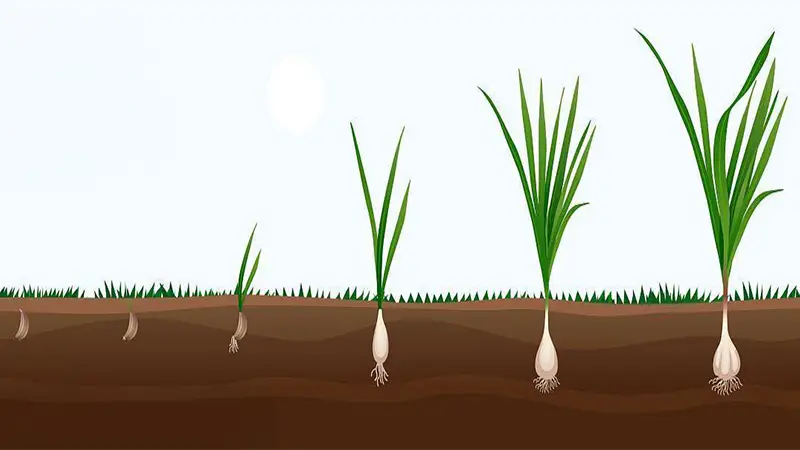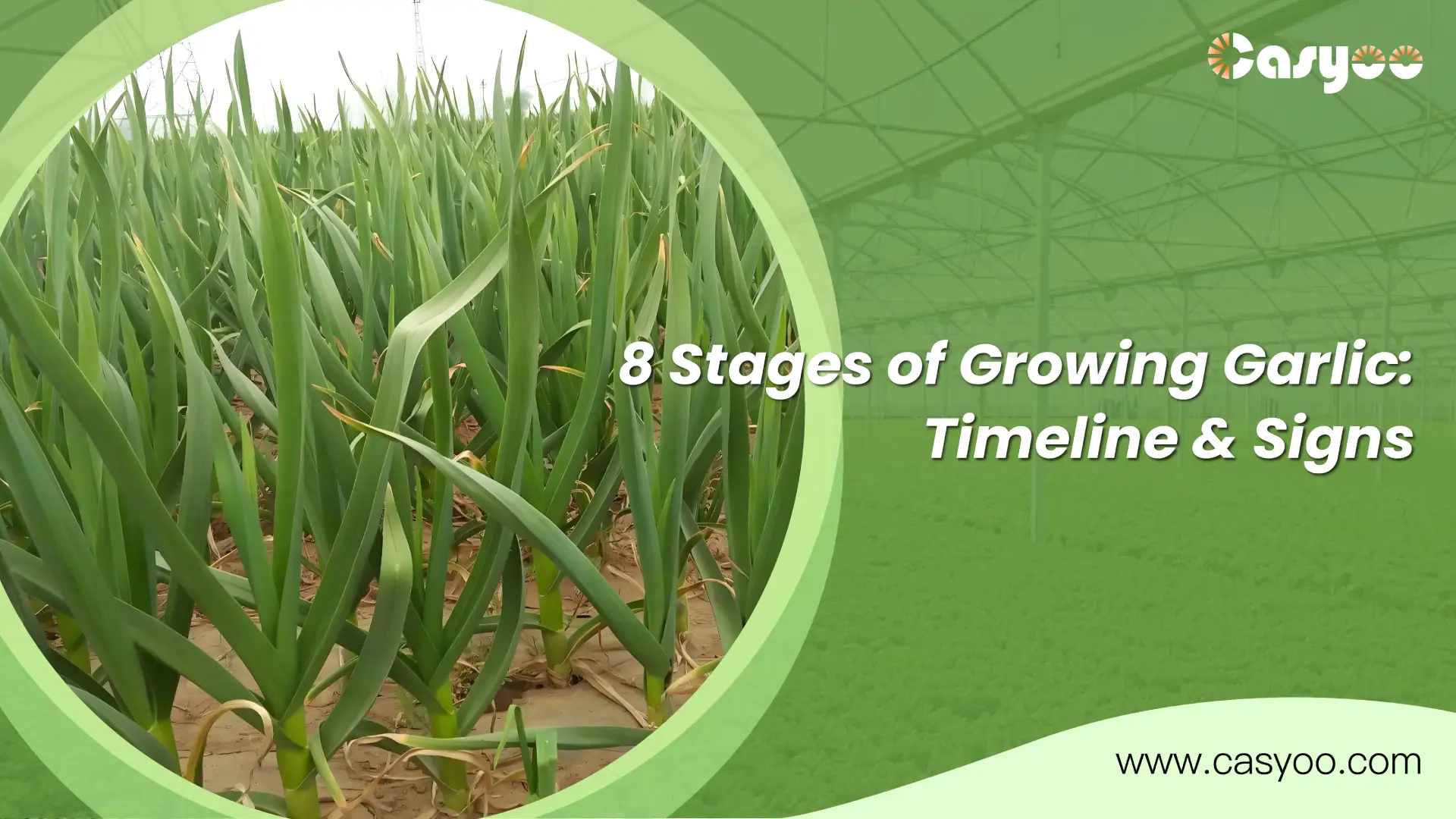Garlic has been a human food for a long time, and people have also discovered its ability to kill bacteria. Garlic has been fully integrated into human life, and is consumed and used for medical purposes in various civilizations and lands. Below, we will carefully introduce the garlic growing stages.
8 Stages of Growing Garlic
Taking the First Step: Strategic Fall Garlic Planting
For planting garlic, timing is crucial, and to seize the opportunity, sufficient preparation is needed. The ideal planting window is 4-6 weeks before the ground freezes, usually between September and early November, depending on the climate in your area. To garlic growing stages, the first step is to choose a place with sufficient sunlight and good soil drainage. In the process of composting garlic, it is important to ensure that the soil is loose and fragile, and the depth of garlic should be 8-10 inches. Within 24 hours before planting, dismantle the bulbs of garlic, select the largest and healthiest outer garlic cloves, and use this type of garlic as seeds. The garlic will definitely grow well in the coming year.
The planting process itself requires great attention to detail. The depth of the plow groove is approximately 2-4 inches, the spacing between garlic cloves is 4-6 inches, and the tips of the garlic cloves face upwards. The distance between rows of garlic seeds is 12-18 inches. After planting, water first, and then cover a 4-6 inch thick insulation layer with clean straw, leaves, or grass clippings. This insulation layer is very important for garlic to survive the winter, as it can protect soil temperature and maintain soil moisture., This provides the necessary conditions for the growth of garlic in spring.
The Secret Life Underground: Garlic’s Winter Root Development
In the seemingly calm months of autumn and winter, garlic is in a critical developmental stage that occurs quietly underground, and ordinary people cannot see this change in garlic. After planting garlic, before the ground freezes, garlic cloves mainly focus on root growth. Garlic bulb sprouting begins after garlic planting, as garlic bulbs utilize their internal energy to grow white roots from the bottom. These roots eventually grow to 4-8 inches long, laying a solid foundation for garlic’s spring growth.
Although garlic has grown roots in winter, its roots are in a dormant state. These roots only provide appropriate nutrients for cells to maintain their activity, preparing to resume their critical role when spring arrives. The roots of garlic form a beneficial relationship with microorganisms in the soil, especially mycorrhizal fungi, which will help the plant obtain nutrients and water when recovering growth.
The root system development of garlic in winter is a process that shows no signs on the surface, but it also accumulates strength for later growth.
Spring Awakening: The Moment Garlic Breaks Through
As winter passes, the temperature gradually rises, and the soil temperature also gradually climbs above 4 ℃. After a long wait and accumulation, garlic finally reached the critical moment of growth. The white tender branches of garlic penetrate through the soil and insulation layer, marking a crucial transition from dormancy to active growth. This process is consistent with natural climate change, usually coinciding with the flowering time and the return time of birds in spring.
This is the awakening garlic growing stages, where the tender branches of garlic break through the insulation layer and the green buds slowly bloom. When sunlight shines on the newly formed green shoots, photosynthesis begins, providing the main energy source for plant growth. Garlic cloves also store a large amount of nutrients, which provide a lot of material and energy for plant growth, and garlic leaves are also growing rapidly. At this time, garlic requires a lot of sunlight exposure. If there is not enough sunlight during the day, we need to use plant lights to supplement the light.
The timing and strength of spring emergence can tell you a lot about your garlic’s health:
- Strong, thick sprouts indicate well-established roots
- Early emergence suggests proper fall planting depth
- Even sprouting across the bed reflects consistent planting
- Pale or yellow shoots might signal too much mulch
- Patchy emergence could indicate winter damage
The Great Green Expansion: Garlic’s Spring Leaf Growth Phase

Spring is the energy accumulation stage of garlic, during which garlic can grow rapidly and expand its leaves. Each leaf not only represents a green energy machine, but also serves as the future packaging layer around the developing underground bulbs. The number of leaves is a valuable tool for the quality of garlic. The number of healthy leaves on the ground in spring is directly related to the protective packaging of mature bulbs, which can affect the size and storage life of garlic.
During this vigorous growth period, garlic needs three key resources:
- Consistent moisture (about 1 inch of water per week)
- Regular nitrogen feeding (especially early spring)
- Full sun exposure (6+ hours daily)
Leaf development follows a predictable pattern:
- First leaves emerge narrow and spear-like
- Each subsequent leaf grows broader
- Leaves spiral outward from center growth point
- Outer leaves mature while inner leaves develop
- Each new leaf signals potential bulb size
The Graceful Dance of Scapes: Late Spring’s Garden Gift
The garlic style in late spring is the most charming time, when the garlic leaves are lush and green, and they spit out their own flower stems (curled flower stems winding from the center of the plant). These flower stems are an attempt by garlic to open seeds for flowering and translation, although garlic has long adapted to primarily reproduce through garlic cloves. This condition of garlic usually occurs in late May or early June, indicating that garlic has entered a critical developmental stage.
The Scape Decision Window:
- Harvest when scapes form their first curl
- Usually appears 2-3 weeks before bulb harvest
- One scape per plant
- Stems are tender and bright green
- Length varies from 6-24 inches
The Underground Transformation: Garlic’s Bulbing Phase
In late spring and early summer, garlic undergoes significant changes, but these changes occur beneath the soil, where a clove of garlic begins to split into multiple cloves. At this stage, the sunshine duration is long, the soil temperature is relatively high, the speed of plant photosynthesis is fast, and the growth and development of garlic is also relatively fast.
At this stage, attention should be paid to water management of garlic, and irrigation should be gradually carried out during planting. Irrigation should be completely stopped 2-3 weeks before harvest.
The Final Act: Garlic’s Summer Maturation Stage
With the arrival of summer, garlic plants undergo a series of changes, and the growth of garlic also changes from prosperity to decline. The time for surface harvest is coming soon. At this point, garlic stores all its nutrients and substances in mature bulbs instead of promoting growth. At this point, the leaves of garlic begin to slowly turn yellow and dry, while the packaging layer of garlic gradually forms, and the garlic cloves form a unique flavor substance.
Key Signs of Maturation:
- 50-75% of leaves turning yellow
- Bottom leaves drying completely
- Upper leaves still partly green
- Neck of plant begins to soften
- Bulb wrappers tightening
Flavor Development:
- Compounds intensify as bulb dries
- Allicin content increases
- Clove structure firms up
- Wrapper layers become papery
- Distinct variety characteristics emerge
The Grand Finale: Mastering Garlic Harvest Timing and Technique
The harvesting time of garlic is very important. If it is harvested too early, the bulbs will shrink due to thin skin, and if it is harvested too late, the bulbs will start to crack and spoil. When 50-75% of the leaves turn yellow, but a few of the leaves on top are still green, this is the best time to harvest garlic.
Proper Harvesting Steps:
- Soil Preparation
- Water lightly 2 days before if soil is rock-hard
- Never harvest from wet soil
- Loosen soil around bulbs carefully
- Lifting Technique
- Use a digging fork, not a shovel
- Work 6 inches away from bulb stems
- Gently pry up from multiple angles
- Never pull plants straight up by stems
- Keep bulbs attached to stems
- Immediate Post-Harvest Care
- Brush off excess soil gently (don’t wash)
- Keep in single layers
- Move to curing area within hours
- Protect from direct sunlight
- Maintain good air circulation
FAQs About Garlic Growing Stages
When is the best time to plant garlic?
Plant 4-6 weeks before ground freezes, typically late September to early November in most regions.
Can I plant garlic in spring?
Sure, but the bulbs of garlic planted in spring are relatively small.
Can I plant grocery store garlic?
Not recommended – it’s often treated to prevent sprouting and may carry diseases. Use certified seed garlic from reliable suppliers.
How long does garlic take to grow?
8-9 months from fall planting to summer harvest.
How many leaves should healthy garlic have?
Typically 8-12 leaves; each leaf represents one wrapper layer on the final bulb.
Should I fertilize garlic?
Yes – mainly in early spring when active growth resumes. Stop fertilizing when scapes appear.
How do I know when garlic is ready to harvest?
When 50-75% of leaves have yellowed but several upper leaves remain green.
Can I cure garlic in direct sunlight?
No – cure in a well-ventilated, shaded area to prevent sunburn and preserve quality.




